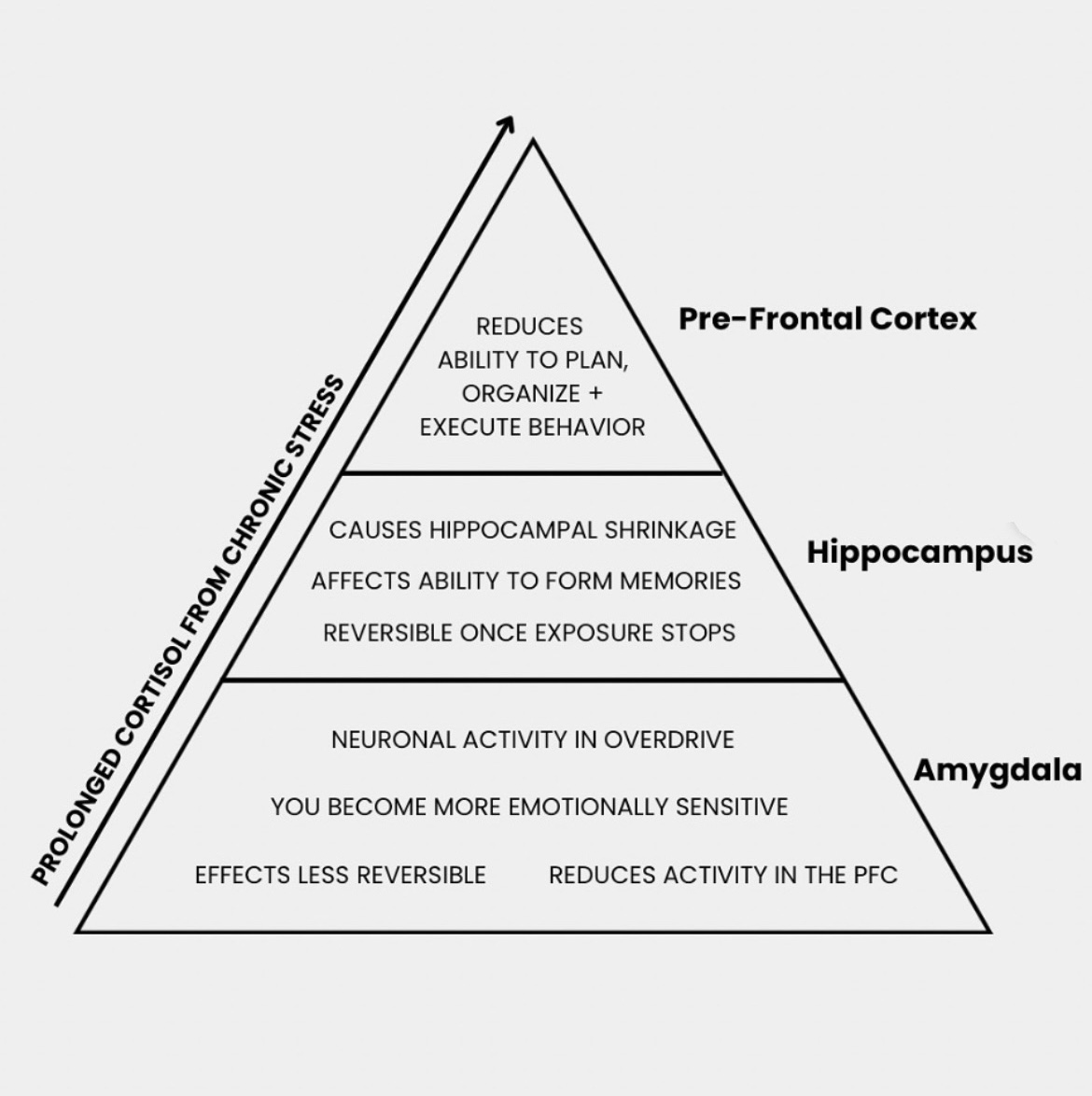Even if you’re usually as cool as a cucumber, you probably experience feelings of anxiety from time to time. Often appearing as a sense of dread or uneasiness, anxiety can be triggered by many things in your day-to-day life, such as a big presentation, a final exam, or even asking someone out.
Here, we’ll explore what happens in your brain when you experience anxiety, plus some neuroscience-backed tips to help you work through it.
READ MORE: From Stressed to Strong: How Oura Helps This Member Destress, Stay Sober, and Inspire Others
What Is Anxiety?
“Anxiety is a part of life, and can be a normal reaction to stressors in your life,” says Liadan Maire Gunter, a neuroscientist and behavioral change consultant.
While symptoms of anxiety can present differently for each person, they can be:
- Emotional, such as feelings of nervousness, restlessness, tension, or dread.
- Physical, like an increased heart rate, rapid breathing, sweating, trembling, muscle tension, stomach upset, or headaches.
- Cognitive, making it hard to focus, causing racing thoughts, or leading to negative or catastrophic thinking.
While it may not sound pleasant, it’s important to note that some short-term sources of anxiety can actually benefit you. “In some instances, anxiety can even work to your advantage, boosting your motivation or heightening your performance,” Gunter explains.
When your brain detects a threat—real or perceived, like a test, big deadline, or first date—it triggers the body to release hormones, including adrenaline and cortisol. These hormones help your body mobilize its energy stores, giving you motivation to take on the challenge that lies ahead.
Studies suggest that cortisol may also boost memory formation, learning, focus, and performance, and it can aid in building resilience—your ability to recover from stress.
However, long-term anxiety and excessive exposure to stress hormones like cortisol can wreak havoc on your body, disrupting nearly every system in your body, which significantly increases your risk for a wide range of health issues.
| Note: It’s important to distinguish between normal anxiety and anxiety disorders. When anxiety becomes excessive, persistent, or interferes with your daily life, it might indicate an anxiety disorder. If you’re concerned about your anxiety levels or think you might have an anxiety disorder, it’s essential to seek professional help. |
RELATED: Reframing Stress: The Difference Between “Bad” and “Good” Stress
How Anxiety Rewires Your Brain
When anxiety or stress lingers and becomes chronic, it can lead to changes in the brain’s structure and function. This is often referred to as “rewiring” the brain, although it’s important to remember that your brain is constantly changing and adapting throughout life.
Here are some ways anxiety can impact the brain:
-
- Increased amygdala activity: The amygdala, the brain’s emotional center, becomes more active and sensitive, Gunter explains. This can make you more emotional or fearful in anxiety-inducing situations, even if they’re not objectively life-threatening.
- Weakened prefrontal cortex: The prefrontal cortex, responsible for rational thinking, planning, and decision-making, can become less effective when you experience anxiety, Gunter notes. This can make it harder to control anxious feelings and prevent them from escalating.
- Changes in neural connections: Chronic anxiety can lead to changes in the connections between different brain regions. For example, connections between the amygdala and the hippocampus (which are involved in memory) might become stronger, making it easier for fear memories to be triggered.
- Reduced neuroplasticity: Anxiety can interfere with the brain’s ability to form new connections and adapt to experiences, which is known as neuroplasticity. This can make it harder to learn new coping mechanisms or overcome fears.
- Possible memory impairment: In some extreme cases, prolonged anxiety can damage cells in the hippocampus—an important structure for memory. “This can cause your hippocampus to shrink, affecting your ability to form memories. This is why when you are undergoing a very stressful period in your life, you may have poor memories of it,” Gunter explains.
Long-term, chronic stress and anxiety impact different regions of the brains, which are all interconnected. Graphic: @liadanmairegunter
| Member Tip: Oura’s Daytime Stress Feature picks up on your body’s physiological stress. While anxiety may not manifest as physiological stress, you can use Tags to track your stress levels throughout the day, helping identify certain anxiety triggers that may have gone unnoticed, like a stressful meeting or being stuck in traffic. |
3 Science-Backed Ways to Manage Anxiety
Here’s the good news: You can use your brain’s neuroplasticity, or adaptability, to your advantage as you work to manage anxiety.
While this is far from a complete list, keep reading for three easy-to-enact tips that allow you to tap into your brain’s innate flexibility.
1. Go outside to broaden your visual field.

Anxiety can cause you to have “tunnel vision,” as you hyperfocus on an anxiety-provoking stimulus. A simple fix: Head outside and take in your surroundings. If you can’t get outside, try to simply relax your eyes or gaze at objects in the distance.
Why this works: “Your brain relies heavily on your visual system to understand your environment, which is why the visual cortex occupies such a large portion of it,” Gunter explains. Broadening your field of vision helps to activate the parasympathetic nervous system (or the rest-and-digest response), which calms your body and relaxes your mind.
Plus, research suggests a strong relationship between the space surrounding us and the passage of time, Gunter notes. In particular, being in large open spaces can slow your perception of time, which allows you to feel more present and less anxious.
While the beach, forest, or mountains may be an ideal backdrop for breaking out of an anxious funk, taking a short walk around the block or your local green space can be just as effective.
RELATED: How Grounding & Forest Bathing Can Sync Your Circadian Rhythm, Combat Stress, and More
2. Try the 5-4-3-2-1 method.
This exercise has gained popularity as a simple and effective way to calm your nervous system by giving you something to focus on—rather than your anxious thoughts.
To try this technique, take a deep breath and mentally make note of:
- 5 things you can see
- 4 things you can feel
- 3 things you can hear
- 2 things you can smell
- 1 thing you can taste
This exercise redirects your brain’s focus by engaging your senses and helping you stay present, giving you a feeling of control in the midst of anxiety.
READ MORE: 10 Simple Breathing Exercises for Sleep and Relaxation
3. Consider somatic exercises.
 Deep breathing, stretching, walking, or simply shaking it off are all “somatic” exercises—physical techniques designed to connect your mind and body to release tension and relax your nervous system.
Deep breathing, stretching, walking, or simply shaking it off are all “somatic” exercises—physical techniques designed to connect your mind and body to release tension and relax your nervous system.
For example, deep breathing can calm your nervous system by slowing your sympathetic nervous system (fight-or-flight) response. Stretching can release built-up muscle tension, and gentle movement like walking can get your blood flowing and encourage physical relaxation.
| Member Tip: Press play on a meditation or breathwork exercise in the Oura App’s Explore Content, which provides post-session biofeedback about how your body responded. |
Remember, anxiety isn’t just in your mind—it’s also experienced in your body. To successfully manage moments of anxiety, try techniques that target both the mental and physical aspects of anxiety for a holistic approach.
RELATED: 9 Simple (and Science-Backed!) Ways to Lower Stress
About the Oura Expert
Liadan Gunter, MSc has a BA in neuroscience from Boston University and an MSc in Research in Behavior and Cognition from Universitat de Barcelona. She works as a behavioral coach for individuals and members of organizations on how to optimize and rewire their brains.











